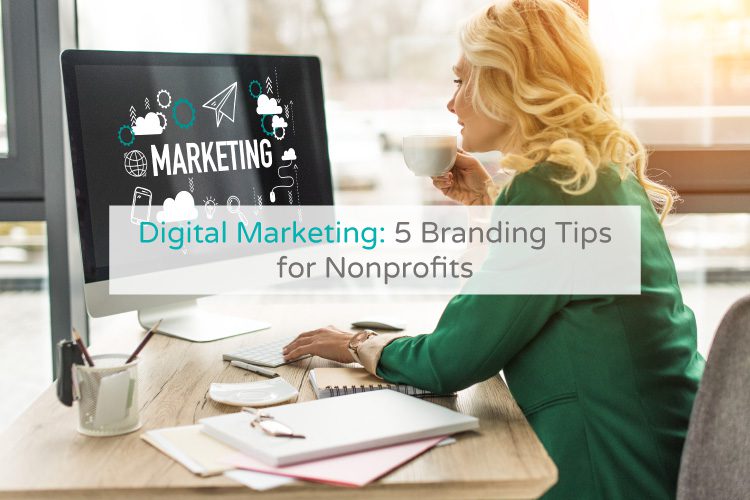Digital marketing has risen drastically in popularity in just a few short years, and many nonprofits have enjoyed the benefits of online outreach, such as increased fundraising revenue, online event attendance, and brand awareness. Branding creates a sense of consistency across outline outreach campaigns, making it a key component of digital marketing. However, many nonprofits struggle to pin down how they can effectively leverage their brand in their marketing.
A nonprofit’s brand is more than just a logo and set of colors. As the best nonprofit websites demonstrate, brand is a cohesive identity that is formed by every aspect of a nonprofit’s external image. While carefully selected colors and a professionally designed logo can get your nonprofit’s digital marketing far, your supporters should come to associate emotion, values, and a specific identity with your nonprofit.
Along with building an identity that differentiates your nonprofit from similar organizations, spreading brand awareness can get technical. To help improve both your brand creation and brand recognition strategy, here are five tips for nonprofits that market online:
- Establish Core Values
- Create and Share Your Brand Guidelines
- Brand Your Forms
- Use Microsites Strategically
- Track Brand Awareness
Remember that a brand identity requires continuous upkeep. Regularly evaluate if your brand identity fits your nonprofit’s current objectives and whether it’s having the desired impact on supporters. Even if the answer to both of these points is yes, following these best practices will continue to reinforce and strengthen your nonprofit’s online brand. Let’s get started.
1) Establish Core Values
An effective brand identity causes supporters to associate emotions and values with your organization. While there are positive characteristics that nearly all nonprofits would like to be associated with, such as professionalism and effectiveness, specific values related to your mission can help differentiate your nonprofit from similar organizations.
Forming an effective marketing strategy around your brand identity requires understanding why your audience supports your nonprofit. For example, a nonprofit dedicated to afterschool education programs might feel that it’s more important to present themselves as technologically proficient than a humane society would. That same afterschool program may also make a conscious decision to center their brand identity around providing sophisticated learning resources to differentiate themselves from a similar nonprofit that focuses their brand on fun and student engagement.
Brand identities that display your nonprofit’s core values help you connect with all sorts of audience members, including corporate sponsors. As this guide to corporate social responsibility explains, corporate sponsors likely already have established philanthropic values. Your brand identity will help form each sponsor’s first impression of your nonprofit and can help them determine whether your values align with theirs.
2) Create and Share Your Brand Guidelines
While your brand may evolve with your nonprofit, your marketing team should sit down and create standardized brand guidelines for both external and internal communication. Having a guide to refer back to will help align your marketing team and benefit three core groups who will have a major role in your marketing campaigns:
- New staff members. A written set of brand guidelines will expedite your nonprofit’s onboarding process, especially for new members of your marketing and communications teams. Guidelines that explain how your nonprofit should present itself can help less experienced staff members communicate with numerous audiences from corporate sponsors to social media followers
- Third-party partners. If your nonprofit outsources services such as copywriting, graphic design, or marketing, you’ll need to have a shareable branding resource on hand. When working with these partners, consider what additional information they will need to get your nonprofit’s brand right. For example, a graphic designer will need multiple assets like your organization’s official colors and logo requirements to recreate your nonprofit’s unique style, while a copywriter might need a list of specific phrases or keywords your nonprofit prefers to use.
- Volunteers. Volunteers can do some of the most impactful marketing for your nonprofit. However, as GoodUnited’s guide to peer-to-peer fundraising points out, “we can assume that supporters participating in your peer-to-peer fundraisers are going to speak highly of your organization and mission—but, they’re not professional fundraisers or entrenched in your day-to-day work.” In other words, even your most ardent supporters don’t know the exact specificities of your nonprofit and may present your brand incorrectly if not provided with guidelines.
Your brand guidelines can be a living document, especially when your nonprofit is first starting out and finding its footing. Establishing brand guidelines that may change later on is still a good idea as it will give your nonprofit a baseline to work with as your brand identity begins to solidify.
3) Brand Your Forms
A consistent brand identity assures visitors that they are interacting with content created by and for your organization. On your website, this helps cultivate a consistent user experience and builds confidence in your nonprofit and your brand. User confidence then translates to feeling secure when giving out sensitive financial and contact information.
Users tend to feel nervous when they click a link that navigates them away from your website and may hesitate to donate if your donation form is unbranded. If your website links users to external forms, be sure that each form features your nonprofit’s logo, colors, and other significant branding elements. You can also get around this problem by finding forms that embed directly into your nonprofit’s website.
Some website builders offer more customization and branding options than others. That way, you can fully brand all of your digital content. Morweb’s guide to nonprofit website builders suggests looking for platforms that allow your nonprofit to:
- Create branded external pages.
- Offer on-site registration and donation forms.
- Have mobile responsive designs that retain your branding elements.
- Expand your nonprofit’s brand to apps and additional mobile resources.
- Customize a wide variety of templates.
Additionally, be sure to brand all external materials with your nonprofit’s logo, so if they are ever taken out of context, they will still refer supporters back to your nonprofit. This is especially true of valuable resources such as images, which may be shared without your nonprofit’s permission.
4) Use Microsites Strategically
Your brand identity should remain consistent to ensure supporters understand your nonprofit as one, cohesive organization. However, your nonprofit can show off and experiment with different sides of your brand identity through the strategic use of microsites.
Microsites are highly focused websites that are external but still connected to your main website. Nonprofits create microsites when they want to create content that is relevant to a very specific event, campaign, or promotion that differs from the content that can be found on their main website. Considering that microsites are external from your main website, they provide an opportunity for your nonprofit to slightly adjust its brand identity to appeal to a new audience.
For example, your nonprofit might create a microsite for a fundraiser like Giving Tuesday. Along with basic content such as a donation form, your nonprofit might add engaging content that wouldn’t fit quite as well with your main website, such as:
- Gamification features. Gamification features include fundraising thermometers, leaderboards, and other tools that boost fundraising engagement.
- New products. Creating a separate microsite for merchandise allows your nonprofit to create dedicated product pages and catalogues for branded merchandise.
- Unique fundraising language. Your nonprofit will likely talk about your mission, impact, and current programs in different ways based on your current objectives. Microsites provide the freedom to use language specific to one fundraiser without worry about how it applies to your other fundraising activities.
- Event specific live-streams. Live-streams are a core part of virtual event microsites, allowing your nonprofit to entertain and interact with supporters throughout the night in real-time.
Microsites also help spread your nonprofit’s brand by attracting more online supporters. Creating an additional website means supporters that search keywords related to your nonprofit have a higher chance of finding a site created by your nonprofit.
5) Track Brand Awareness
It’s unlikely your marketing strategy will be perfect, especially if you are launching a new brand identity. While some missteps may be obvious, others require taking a deeper look at your marketing strategy and subsequent response rates. Of course, you can only access this data if you’re tracking it in the first place.
Brand awareness can be difficult to measure, but you can collect data using your marketing materials that indicate how supporters are responding to your messaging. Before posting your content online, make sure you have the web analytics tools in place to track these metrics:
- Website and referral traffic. Your website traffic is how many people visit your website overall, and referral traffic indicates visits to your site from links that appear on different sites. After a marketing campaign, you should see an increase in both, and your referral traffic can help indicate who is talking about your campaign outside of your nonprofit.
- Social media activity. Whether you measure it in likes, followers, retweets, comments, or other platform-specific conventions, social media engagement provides a window into how individual supporters feel about your nonprofit. Examine what posts receive attention and how those posts reflect your nonprofit’s brand identity.
- Share of voice. Share of voice examines how much attention your nonprofit receives compared to similar organizations. Share of voice can refer to multiple measurements such as how many mentions your nonprofit receives on social media to traffic for target keywords. By measuring share of voice, you’ll be able to compare your brand awareness to that of similar organizations, grounding your data in real-world comparisons rather than abstract numbers.
You can also track brand awareness by using surveys to outright ask supporters what they associate with your nonprofit. It’s likely your most ardent supporters will be the main audience for your direct surveys, meaning they may not provide a wide survey pool. However, surveys still have their uses, especially if your nonprofit is considering rebranding and needs to know what elements to keep and what can be improved.
The Gist
Virtual spaces allow your nonprofit to connect with a wide audience of supporters, but they can also be highly competitive. Your nonprofit can stand out from the crowd by forming and promoting a brand identity that communicates your nonprofit’s values and creates a consistent experience for supporters interacting with your nonprofit.
By establishing your brand identity, you’ll instill a sense of trustworthiness among supporters. All you need to get started is a mutual understanding of how your team should represent your brand and the resources to begin crafting your new brand guidelines.


































